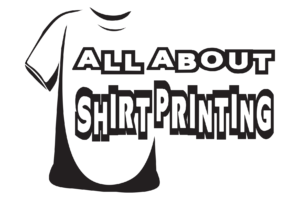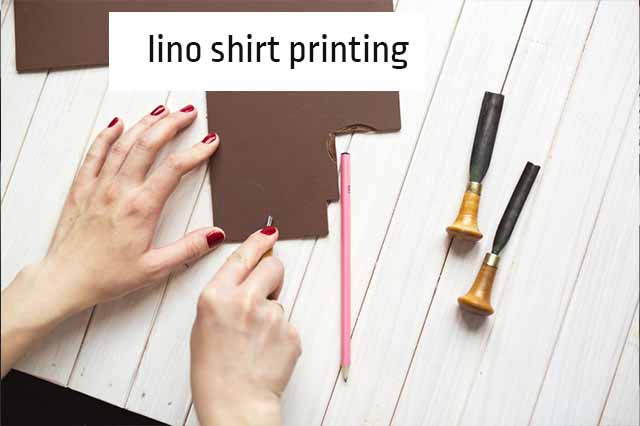In the article we will look at how you can print lino prints on shirts or fabrics at home.
what is lino?
Linoleum, also known as lino, is a type of soft and flexible material made from linseed oil, pine resin and wood dust.
It was invented in the mid-19th century as a cheaper and more durable alternative to traditional floor coverings such as cork and rubber, and for the flooring industry it is available in sheets or tiles and can be cut to fit a variety of shapes and sizes.
Linoleum is also used by the construction industry and is known for its durability and resistance to moisture, making it a popular choice for use in kitchens, bathrooms and other high-traffic areas.
It is also easy to clean and maintain, and can be waxed or polished to restore its shine.
In addition to being used as a building material, linoleum is also used in a variety of other applications, including printing, where it is known as lino.
In printing, linoleum is carved using special tools to create a relief print, which is then adhered with ink and pressed onto paper or fabric to create a print.
Linoleum is popular for printing due to its versatility, ease of use and low cost.
Block print
Block printing is a printing technique in which the design or graphic to be printed is carved into a block of wood, linoleum, or other material that can be carved.
Ink is then applied to the carved block and then the block is pressed onto paper or fabric to create a print.
The block is carved in such a way that the raised areas of the block hold the ink, while the sunken areas do not.
When the block is pressed on top of the material on which you want to print, the ink is transferred from the raised areas to the surface, and thus the print is created.
Block printing is a popular method of printing because it is relatively simple to perform and because it is versatile.
This type of printing can be used to create a wide variety of designs, from simple line drawings to more complex compositions.
On the other hand, color printing is less suitable for using this method.
As home printing, block printing can be done quickly and in large quantities – provided the design is uniform, which makes it a suitable method for producing duplicates of the same design.
As industrial printing, this method is less suitable because screen printing produces better results in fewer work steps.
Block printing is also an economical way to create prints, as it only requires a few basic materials and tools.
What is a lino print?
Lino printing, (or in its full name linoleum printing) is a printing technique that uses a linoleum block to transfer a design to another material, and is a type of relief printing.
The way to do this is by carving the desired design into a piece of linoleum and then coating the lino with ink and pressing it onto paper or fabric to create a print.
Lino prints can be made more easily than block or relief prints because lino is a relatively flexible material that can be carved easily (unlike wood, for example).
Lino prints are used in the field of art to print on paper, but it is equally possible to use this type of print to print on clothing or textiles.
The main difference between printing on paper and printing on textiles is the type of ink we will use: when printing textiles we will need ink designed for fabric and after printing we will have to make sure that the ink has set well so that it does not come off in the wash.
Advantages and disadvantages of lino printing
As with any printing method, lino printing also has advantages and disadvantages that we need to know in order to know if this method is suitable for our needs and abilities.
Lino print advantages:
- The process is relatively easy to learn and can be done with simple and inexpensive tools.
- The work process allows for a wide range of creative expression.
- Lino prints can be made quickly and in large quantities, which makes it a suitable method for producing duplicates of the same design.
- Since mostly water-based colors are used in this type of printing, the print is more delicate to the touch than plastisol ink.
- The process of carving the linoleum block can be therapeutic and relaxing.
Disadvantages of lino printing:
- The amount of time it takes to carve the lino – especially when carving complex designs.
- It is important to plan well before starting the carving because it is almost impossible to correct mistakes.
- Lino printing is a relatively low resolution printing method, so fine details may not appear clearly in the print.
- It is not possible to use lino to print a different design, so you have to use a new block of lino for each design.
Lino dyes for textiles
Lino dyes are water-based dyes that are specially formulated for use on fabric and other textiles. They can be used to create designs and patterns on fabric using the lino printing technique, in which a design is carved into a piece of linoleum and then inked and pressed onto the fabric to create a print.
Lino dyes are typically more vibrant and colorfast than other types of fabric dyes, and they can be used on a variety of fabrics including cotton, linen, silk, and wool. They can be applied using a roller or brayer, and are easily thinned with water for transparent effects or mixed together to create new colors.
Lino dyes are permanent and will not fade or wash out of the fabric once they are set. They are also non-toxic and safe to use, making them a popular choice for printing on fabric.
WATER BASED LION INK
Water-based LION INK is a type of ink that is made from water-soluble pigments and a water-based carrier. It is commonly used in printing, drawing, and other art applications, and is known for its ease of use and versatility. Unlike solvent-based inks, which are made with chemicals that can be harmful to the environment and to the user, water-based inks are generally considered to be safer and more environmentally-friendly. They can be used with a variety of printing and drawing tools, including pens, brushes, and printing presses, and are easy to clean up with water. Water-based inks are also typically non-toxic, making them a popular choice for use with children and in schools.
OIL BASED LINO INK
Oil-based lino ink is a type of printing ink that is made from a combination of pigments, oils, and resins. It is commonly used in printmaking, particularly in the linocut printmaking process, and is known for its ability to produce sharp, crisp lines and rich, vibrant colors. Unlike water-based inks, which are made with water-soluble pigments and a water-based carrier, oil-based inks are made with pigments that are suspended in oil, which gives them a thicker, more viscous consistency. This makes them ideal for use with linoleum blocks and other printing surfaces that require a lot of pressure to transfer the ink. Oil-based lino inks are generally more durable and long-lasting than water-based inks, and are resistant to fading and deterioration over time. However, they can be more difficult to clean up than water-based inks, as they require the use of solvents to remove them from printing tools and surfaces.
lino shirt printing step by step guide
To print a design onto a shirt using the lino printing technique, you will need the following materials:
- Linoleum block
- Shirt of your choice
- Carving tools
- Fabric paint or ink in the color of your choice
- Roller or brayer
- Cutting mat
- Pencil
- Scissors
Here is a step-by-step guide to lino printing a shirt:
- Begin by sketching your design onto the linoleum block with a pencil. You can also trace a design from a photograph or other image if you prefer.
- Next, use your carving tools to carefully carve out the design on the linoleum block. Be sure to carve away the areas that you want to be left blank on the shirt, as the paint or ink will only transfer to the raised areas of the block.
- Once your design is carved, mix the fabric paint or ink according to the instructions on the package. Roll a layer of paint or ink onto the linoleum block using a roller or brayer. Be sure to evenly coat the entire surface of the block with paint or ink.
- Place the shirt onto a cutting mat, and carefully lay the inked linoleum block onto the shirt. Use a roller or brayer to apply even pressure to the block, pressing it firmly onto the shirt.
- Carefully lift the linoleum block off of the shirt to reveal your printed design. You may need to repeat the printing process several times to achieve the desired intensity of color on your shirt.
- Once you are happy with the print, allow the paint or ink to dry completely before handling the shirt. You can then wash and iron the shirt as usual, taking care not to iron directly over the printed area.
With practice and experimentation, you can create beautiful and unique printed shirts using the lino printing technique.

